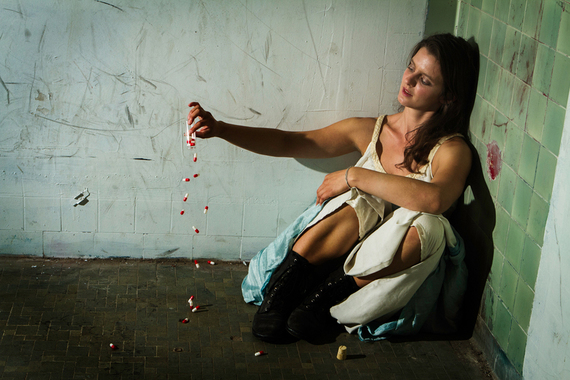You might leave Then She Fell with more questions than answers, but that's part of the amazement. This immersive theater experience pushes you to examine the limits of reality and to free your mind to possibility. Plus, the choreography goes well beyond mere dance. Everything you witness in this madhouse is full of complexity and planning. Marissa Nielsen-Pincus, who has worked with Third Rail Projects for over a decade on top of performing in Then She Fell, is also rehearsal director for the production. She replied to my questions via email:
This show is so immersive and engaging. There's never a spare moment to catch your breath. What's it like to perform inside this madhouse? Is it a race to stay ahead at all times?
Nielsen-Pincus: The show is very non-stop for the performers. I have about two minutes in the entire two-hour show where I am not with the audience. But I wouldn't call it a race to stay ahead of time. I always know where I need to be and when I need to be there and there is actually a little bit of forgiveness within the structure that allows us adapt to what happens with any particular scene or audience member. By the end of the night I do tend to feel like I've been caught in a strange time warp along with the audience.
"Alice" is such an intriguing character, who says more with her dancing and body movements than anyone else in the cast. For me, it was her darting stares that left me most struck. What goes into the role?
Nielsen-Pincus: For me, the most important thing about being Alice is to be very present, open and in a receptive state. As Alice, there is a lot of eye contact with the audience, which is quite powerful. It's as much about looking at someone as it is taking in what you see and sharing that moment of seeing and being seen with the audience. As performers, and especially in this kind of intimate setting, we have to constantly remember to do less, otherwise we come across as caricature of ourselves.
Photo by Adam Jason Photography
Your dance with Lewis Carroll is one of the highlights of this performance. The choreography is magnificent, leaving the audience with a feeling of both love and mayhem. How did that scene come together?
Nielsen-Pincus: That's a nice way to describe it. There is very strong eye contact between Alice and Lewis Carroll that is almost unbroken throughout the entire scene. And within that eye contact, we play a lot with proximity -- moving closer and farther, spiraling around each other, and up and down and over the stairway -- which creates a kind of force field or tangible tension between us, so that when we finally come together its a strong moment.
But you're not the only "Alice" in this production. Seeing two Alices at times, and then together, leaves a haunting impression. Mirrors and reflection play a strong role over the course of the evening. What's the underlying message there about duality?
Nielsen-Pincus: I actually love hearing the audience's interpretation of who the 2 Alices are... good/bad, young/old, wonderland/looking glass... there are many versions and some that I never thought of. I feel like sometimes we are simply each other's reflection in a mirror and at other times we are manifestations of the opposing desires and pulls within one person, the different sides of a personality and the different direction we could go in and the decisions we make in life that send us one way or another.
The story comes together in pieces, but it doesn't feel like a detective story where you must solve the puzzle. What do you hope the audience walks away considering and wondering about?
Nielsen-Pincus: I feel like the show accumulates meaning as it goes... images and experiences layering on top of each other. We introduce a lot of ideas -- love, loss, duality, this story of Lewis Carroll and Alice, and who you are as an audience member and what you connect to informs how you interpret the show. We think of it like a Rorschach test. The really interesting thing for us is not the audience figuring out what happened between Alice and Lewis Carroll, but what they connect to personally and how the show effects people on a personal level. There is something about the intimacy of Then She Fell that blurs the line between the story and the characters we are playing with and the audience's own experience and history. We pose a lot of questions. The audience can do with them what they want.
